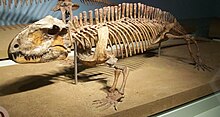| Sphenacodon | |
|---|---|

| |
| Skeleton of Sphenacodon ferox in the Field Museum of Natural History | |
| Scientific classification | |
| Domain: | Eukaryota |
| Kingdom: | Animalia |
| Phylum: | Chordata |
| Clade: | Synapsida |
| Family: | †Sphenacodontidae |
| Subfamily: | †Sphenacodontinae |
| Genus: | †Sphenacodon Marsh, 1878 |
| Species | |
| |
| Synonyms | |
| |
Sphenacodon (meaning "wedge point tooth") is an extinct genus of synapsid that lived from about 300 to about 280 million years ago (Ma) during the Late Carboniferous and Early Permian periods. Like the closely related Dimetrodon, Sphenacodon was a carnivorous member of the Eupelycosauria family Sphenacodontidae. However, Sphenacodon had a low crest along its back, formed from blade-like bones on its vertebrae (neural spines) instead of the tall dorsal sail found in Dimetrodon. Fossils of Sphenacodon are known from New Mexico and the Utah–Arizona border region in North America.
Researchers currently recognize two species: Sphenacodon ferox (the type species) and Sphenacodon ferocior. Sphenacodon ferocior can be up to 40% larger in overall size (at about 3 m [9.8 ft] long) compared to Sphenacodon ferox (at about 2 m [6.6 ft]). In addition, the dorsal spines in Sphenacodon ferocior are proportionately 45% taller than in Sphenacodon ferox. The recent discovery[1] of a nearly complete skull of Sphenacodon ferox has helped clarify other distinctions between the two species, including the number of teeth in certain parts of the jaws and the size of the indented notch between the maxillary and premaxillary bones in the upper jaw. The two species occur together in some formations, but Sphenacodon ferox apparently survived later into the Early Permian.
Sphenacodon and Dimetrodon typically have been found in different geographical areas that were separated by the ancient Hueco Seaway that penetrated equatorial Pangaea during the Early Permian and "covered much of southern New Mexico and parts of West Texas".[2] Sphenacodon is known from the west in New Mexico, Arizona, and Utah, and Dimetrodon is known mainly from the east in Texas and Oklahoma in more deltaic environments. However, the species Dimetrodon occidentalis is found in New Mexico.[3][4] Each genus would have been an apex land predator in its region and likely preyed on amphibians, diadectids, and early synapsids and diapsids.[5] Sphenacodon appears to have died out before about 280 million years ago during the Wolfcampian.[1] The genus Dimetrodon survived until about 270 million years ago. Such large sphenacodontid predators were later replaced by therapsids, the group of synapsids that includes the direct ancestors of mammals.[6]
- ^ a b Spielmann, J. A.; Rinehart, Larry F.; Lucas, Spencer G.; Berman, David S.; Henrici, Amy C.; Harris, Susan K. (2010). "Redescription of the cranial anatomy of Sphenacodon ferox Marsh (Eupelycosauria, Sphenacodontidae) from the Late Pennsylvanian-Early Permian of New Mexico". Bulletin of the New Mexico Museum of Natural History and Science. 59: 159–184.
- ^ Lucas, S. G. (2011). Traces of a Permian Seacoast. Prehistoric Trackways National Monument. pp. 1–48.
- ^ Berman, D.S. (1977). "A New Species of Dimetrodon (Reptilia, Pelycosauria) from a Non-Deltaic Facies in the Lower Permian of North-Central New Mexico". Journal of Paleontology. 51 (1): 108–115.
- ^ Lucas, S.G.; Spielman, J. A.; Rinehart, L.F.; Martens, T. (2009). "Dimetrodon (Amniota: Synapsida: Sphenacodontidae) from the Lower Permian Abo Formation, Socorro County, New Mexico". New Mexico Geological Society Guidebook, 60th Field Conference, Geology of the Chupadera Mesa Region: 281–284.
- ^ Synapsids Sphenacodon, Dimetrodon, Edaphosaurus, and Ophiacodon in a Permian Period landscape as depicted by Rudolph Zallinger for The Age of Reptiles Mural at the Yale Peabody Museum in 1947. https://remodernreview.files.wordpress.com/2015/03/zallinger2.jpg
- ^ Palmer, D., ed. (1999). The Marshall Illustrated Encyclopedia of Dinosaurs and Prehistoric Animals. London: Marshall Editions. p. 187. ISBN 1-84028-152-9.